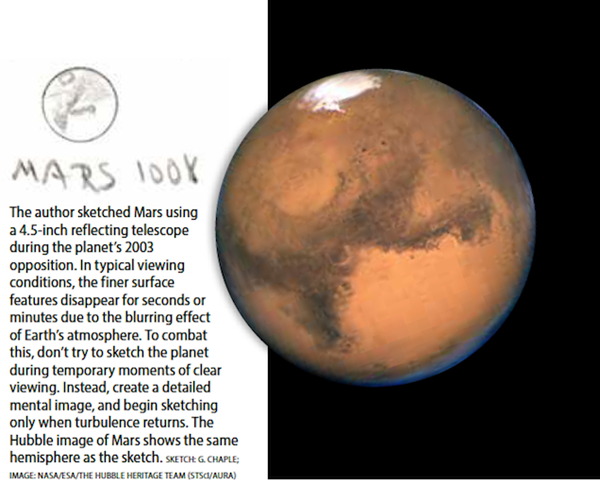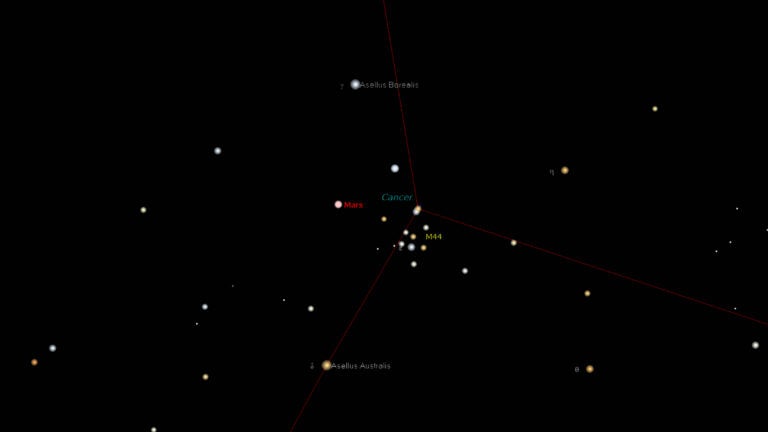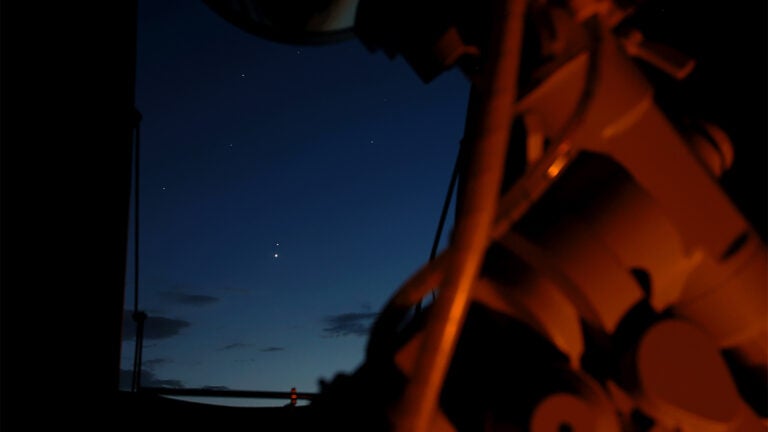“Hear ye, hear ye. Mars is back! Raise the banners, strike up the band.” These opening words of my November 2005 column heralded a favorable appearance of Mars in the evening sky that month. And I’ve written absolutely nothing about Mars in the 13 years since.
It’s not that Mars doesn’t deserve the attention of backyard astronomers; it most certainly does. It’s just that favorable apparitions of Mars — those occasions when the planet is close to Earth during an opposition and its angular diameter equals or exceeds 20″ — are few and far between. The last time Mars appeared this large was November 2005.
A martian year is slightly longer than two Earth years, so oppositions occur every two years and two months on average. So far, so good. But not all martian oppositions are equal. If one occurs when Mars is near aphelion (the portion of Mars’ orbit when it’s farthest from the Sun), the Earth-Mars distance will be on the order of 60 million miles, and the martian disk will be less than 14″ across. When Mars is near the Sun in its orbit (perihelion), its distance from us at opposition shrinks to some 35 million miles, while its angular size balloons to as much as 25″.
Favorable martian oppositions occur in groups of two or three. Between these pairs or triplets are gaps that average 13 years, during which oppositions yield a sub-20″ disk diameter. The last reasonably favorable opposition was the aforementioned 2005 event. The next will happen in October 2020 (angular diameter 22.6″). After that, we’ll have to wait until 2033 (22.1″) and 2035 (24.6″) for the next favorable pair.
Telescopically, Mars is a challenging target even for experienced astronomers. When it’s at its closest this year, you’ll still need a magnification of 75x to enlarge the disk to the apparent size of the Full Moon as it appears to the unaided eye. While you can pick out some planetary detail at that power, 100x to 150x for a small-aperture scope and 200x and up for medium to large scopes is a must. Seeing (a measure of atmospheric stability) will determine how much detail you’ll spot.
And, unfortunately, this opposition of Mars occurred when the planet was in the southern part of the zodiac. For those of us in mid-northerly latitudes, Mars barely breached the treetops along the southern horizon, its disk subject to the whims of atmospheric turbulence. Be sure to observe Mars when it’s as high above the horizon as possible, around 1 A.M. local time on August 1, 10:30 P.M. local time at month’s end.
If you’ve never viewed Mars through a telescope, you’ll be surprised to discover that the Red Planet isn’t red at all. It’s more of an ochre, or yellow-orange color. You’ll also be surprised (unpleasantly) to discover that the martian disk is constantly quivering and contorting, teasing you with vague glimpses of surface detail. If only Mars would settle down and give you a clear view!
Mars isn’t the culprit; the air above us is to blame. Under typical seeing conditions, atmospheric turbulence will “boil” Mars’ image for minutes on end. Then, just when you’re about to give up, the air will settle down, and a crystal-clear Mars will snap into view. For a few fleeting seconds, you’ll see grayish areas and a bright white spot (the southern polar cap). All too soon, the turbulence will return and minutes will pass before another detailed view.
If you’re an astrosketcher attempting a pencil and paper rendering of Mars, wait for those momentary steady periods. When one comes, soak in as much detail as you can. When the turbulence returns, put pencil in hand and sketch in as much as you can. Then wait for the next clear view and repeat. Hang in there, and you’ll come up with a surprisingly detailed drawing. A crude sketch of Mars I made during the 2003 opposition using a 4.5-inch reflecting telescope appears on this page. Compare it with a Hubble image taken when the same side of Mars was facing Earth.
Yes, Mars is back. Be patient and persistent. And most of all, enjoy the show!
Questions, comments, or suggestions? Email me at gchaple@hotmail.com. Next month: Stellar duos you missed during the Double Star Marathon. Clear skies!











